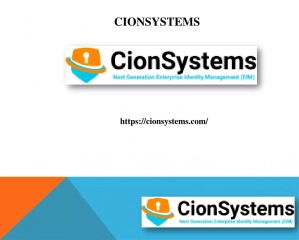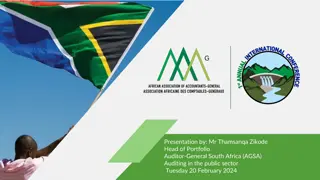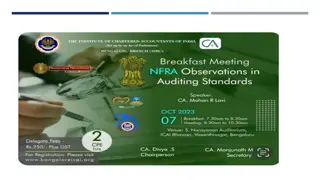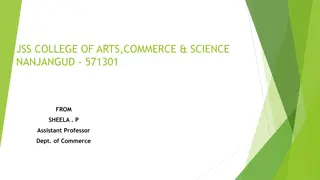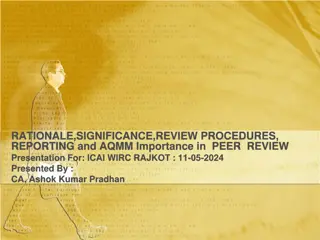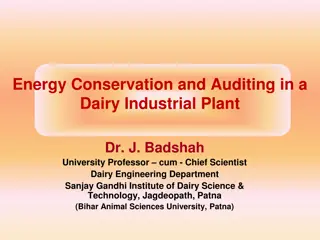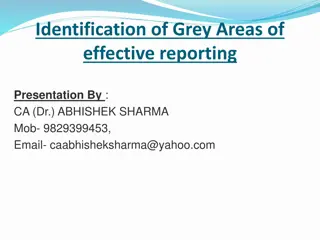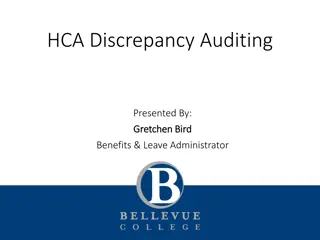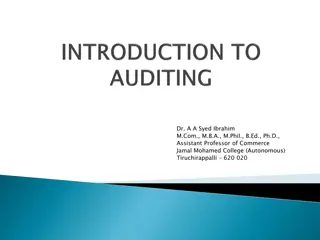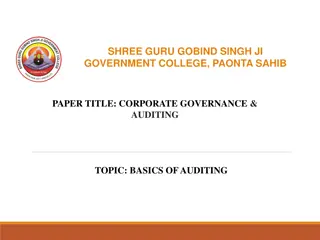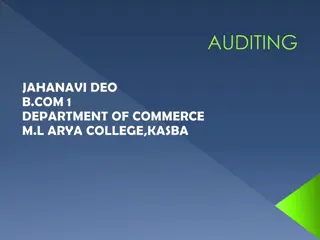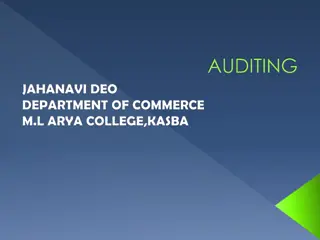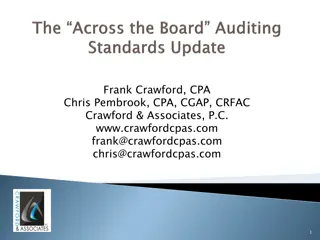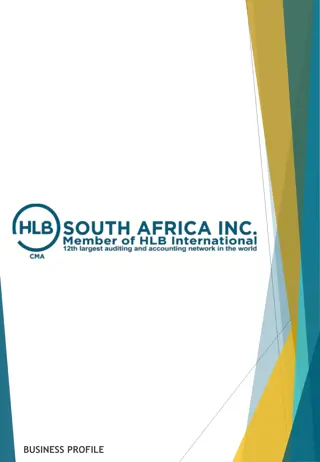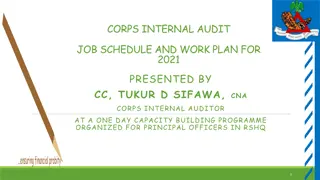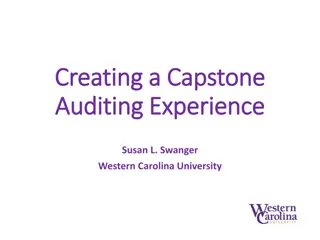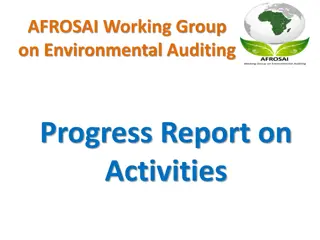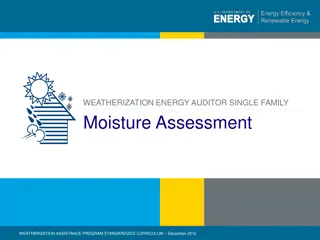Evolution of Auditing in Industry 4.0
The evolution of auditing from manual tools to semi-automated processes in Industry 4.0 is explored in this content. Audit 4.0 utilizes technologies like IoT, CPS, and smart factories to collect data for real-time assurance, marking a significant shift in audit methodologies towards efficiency and effectiveness.
Download Presentation

Please find below an Image/Link to download the presentation.
The content on the website is provided AS IS for your information and personal use only. It may not be sold, licensed, or shared on other websites without obtaining consent from the author.If you encounter any issues during the download, it is possible that the publisher has removed the file from their server.
You are allowed to download the files provided on this website for personal or commercial use, subject to the condition that they are used lawfully. All files are the property of their respective owners.
The content on the website is provided AS IS for your information and personal use only. It may not be sold, licensed, or shared on other websites without obtaining consent from the author.
E N D
Presentation Transcript
Imagineering Audit 4.0 Jun Dai and Miklos A Vasarhelyi
Agenda Background Definition of Audit 4.0 Key Elements Imagneering of Audit 4.0 Challenges Conclusion and Future Research Questions 6
Background Advances in Cyber-Physical Systems (CPS), Internet of Things (IoT), Internet of Service (IoS), and Smart factory promote a new industry revolution Industry 4.0 (Industrie 4.0) became publicly known at Hannover Fair in 2011 The German federal government announced Industry 4.0 as one of the key initiatives to implement the German high-tech strategy 2020 Industry 4.0 is a collective term for technologies and concepts of value chain organization. Within the modular structured Smart Factories of Industry 4.0, CPS monitor physical processes, create a virtual copy of the physical world and make decentralized decisions. Over IoT, CPS communicate and cooperate with each other and humans in real time. Via the IoS, both internal and cross- organizational services are offered and utilized by participants of the value chain. (Hermann et al. 2015) 7
Audit 4.0 Definition Audit 4.0 will piggyback on technology promoted by Industry 4.0, especially the IoT, IoS, CPS, and smart factories, to collect financial and operational information, as well as other audit-related data from an organization and its associated parties It analyzes, models, and visualizes data in order to discover patterns, identify anomalies, and extract other useful information for the purpose of providing effective, efficient, and real-time assurance It is typically an overlay of Industry 4.0 business management processes and uses a similar infrastructure, but for assurance purposes 8
Evolution of Auditing: From 1.0 to 4.0 Audit 1.0 Manual audit Tools: pencils, calculators Audit 2.0 IT audit Tools: Excel, CAAT software Audit 3.0 Inclusion of non- financial data in audit analytics Tools: analytical software Audit 4.0 Semi- and progressive automation of audit Tools: sensors, CPS, IoT/S, RFID, GPS ? 9
Four Elements Standards Principles Technology Auditors 10
Standards Assurance, in the world of Industry 4.0, will be largely dominated by formal inter-object protocols, the technical capabilities of things , and the objective functions of the interlinked objects. Examples: Inventory measurement would be automated by obtaining and tracking the current values of purchases Products will autonomously issue alerts if they are obsolete, slow-moving, or damaged, to prevent including or overstating the value of obsolete inventory Manufactured inventory can be constantly measured by collecting real-time data regarding energy consumptions of production lines and labor costs. Many items that were overhead allocation will be measured directly 11
Principles Interoperability: Traffic lights and cars, automatic confirmation between two related parties Virtualization: a virtual copy of the physical world the Mirror World Decentralization: each machine or device can individual decisions and adjustments Real-time capability: continuous auditing and control monitoring Service orientation: any resource could be served as a service via networks Modularity: using apps for analytics 12
Technology Sensors: collect real-time accounting information, such as quantity and quality of inventory, working hours of employees, energy consumption... Cyber-physical systems: embedded computers and networks monitor and control the physical processes, usually with feedback loops where physical processes affect computations and vice versa Internet of things: objects linked through a network Internet of service: service vendors can offer their services via the internet Smart factories : use CPS, and IoT/S to assist people and machines in the execution of their tasks Others: RFID, GPS, and data analytics 13
Auditors In a world of intense automation and process scrutiny, the skillset of auditors is to change dramatically. The auditor must be much more technically trained, but processes must also be built with untrained users in mind. Auditors will have specialized dashboards that will include close to real time alerts Byrnes (2015) developed a super-app to supplement auditor usage of clustering. This tool not only performs clusterization but also applies statistical knowledge to complement auditor knowledge. 14
Challenges Digital crime: technique given, technique taken Security and privacy issues of companies data Standardization of information and data 19
Conclusion This paper foresees the impacts of the fourth industrial revolution on the auditing profession, imagineers the use of new schemata promoted by Industry 4.0 for audit purposes, and identifies challenges in the transformation towards the new generation of auditing. 20
Future Research Questions What new types of audit evidence can be generated and collected in the context of Audit 4.0? As more data will be collected in Audit 4.0, how can auditors avoid information overload to find relevant auditing information? How should the auditing standards be changed to adapt to the next auditing environment? What are the new audit procedures to be developed/ created in Audit 4.0? What new knowledge should auditors obtain to perform audits in Audit 4.0? What should be done to protect the security and privacy of companies sensitive information in Audit 4.0? 21
Future Research Questions (cont.) How should external and internal auditors cooperate to enable Audit 4.0? Will the current audit model be changed in Audit 4.0? What are the new roles of the different lines of defense? How can predictive and prescriptive audits be used in Audit 4.0? Audit 4.0 will considerably lower the cost of auditing procedures. These are typically the result of tradeoffs of the cost of a particular procedure versus the benefits of such examination. How will this change the depth of examination, the procedures used, and their frequency of usage? As many emerging technologies/systems are used in Audit 4.0, what are new controls that should take place to examine whether the technologies/systems operate as they are supposed to do? 22
A conceptual framework of an audit plan cognitive assistant Qiao Li Miklos A. Vasarhelyi Rutgers, the State University of New Jersey
Introduction What is Audit Plan Brainstorming Session: Purpose: Identify risks and discuss how a material misstatement, whether fraudulent or erroneous, could occur (AICPA, 2016, Landis 2008, Hammersley et al. 2010, Beasley and Jenkins 2003) Common procedure: Checklist Open-ended form (Bellovary and Johnstone 2007) Limitations with Checklist: Structurally-restrictive tool limits new ideas generation & induces biases Uncollected experience and expertise No information retrieval or recommendation support Current computer assisted audit tools and techniques (CAATTs) cannot provide effective decision support for audit planning risk assessment 1/13
Proposed Audit Cognitive Assistant Luca Open an application Luca Luca industry Luca Interface Luca Query Client Processing Recommended Topics: General understanding, new events, business risks Position You may also interested in: Domain: judgement or experience Unstructured: financial statements, accounting policies, Show Answer Answer Modules: Capability Search engine such as google ACL, IDEA Ratios; others like Benford s law Regulations related to the audit area or account Required procedures, guidance or programs Open prior audit Audit plan schedule Ap p 1 2 3 Automatic Speech Query Classifier analytical procedures, litigation, claims, recent news information, audits workpapers, prior year audit deficiencies and adjustments User interaction: queries and search Architecture Automatic Speech Recognition QA Recognition (ASR) Language Understanding Knowle dge Base Question or Action 4 Dialogue Management DBMS Natural Language 5 text Generation Action 6 7 Text-to-Speech synthesis Execute Action Audit Related ApplicationsIt Can Access Knowledge Database Open (ACL, IDEA ) Web Search Calculato r backstage s Domain Knowledge Knowledge about users Unstructu red data upporter Open standards Open templates Audit work paper 4/13 Calendar .
Luca Q-A Module Answer Answer Selection Question Question Analysis Knowledge base Machine Learning Models Answer with highest score Normalized Question Doc. With Candidates Generated Query Keyword extraction; Punctuations, abbreviations, nouns and verbs Query Generation Answer Matching Answer Extraction + IR-based (Domain) QA + Knowledge-based (Cognitive) QA DBMS Paired QA Answer NL Answer Generating 5/13
Application to other audit phases Major phases of an audit: Client acceptance, preliminary engagement activities, audit plan, internal control audit, business processes and accounts audit, audit completion (Messier et al. 2016). Client acceptan ce Preliminary engagement activities Audit plan Internal control audit Business processes and accounts audit Audit completion Decision support in the cognitive assistant -Information Retrieval -Recommendations -App connections Collected Knowledge -NLP conversation 10/13 analysis framework
Application to other audit phases Application of the proposed tool to: Client Acceptance Decision Support Information Retrieval Detailed design Technical support and knowledge sources Question Sub-question categories categories Management Management integrity, Management tone toward financial reporting, management competence, turnover of key personnel; Available files: entity documents and reports Financial health Financial distress, financial leverage, profitability of company, company cash flow, stock volatility Complexity of company, business changes, Accounting & Finance Dept personnel competence, internal controls, litigation risk/ prior restatements, significant related party transactions, strain the client puts on the audit firm s staff, reasons for change of auditors Audit committee competence, Audit committee financial expertise Availability of appropriate personnel, sufficient expertise of personnel, profitability of engagement Client Continuance Significant event; conflicts over accounting and auditing issues; disputes over fees files financial statements, income tax returns, etc. - Regulations, audit standards - Received inquiry from third parties - Notes from meetings discussion - Memo or completed entity acceptance questionnaire or checklist - Documented inquiries from predecessor auditor - Copies of working papers from predecessor auditor - Risk rating from audit programs Collected knowledge teleconference, meetings, inquiries Collected knowledge: Documented observations and inquires; converted inquires and meeting discussions Company characteristics Knowledge type Details Format to save in the QA system Governance Auditor characteristics Sub question categories; Updated related topics discovered from adaptive learning module Recomme ndation Pre-defined recommendation table; Adaptive learning module Service Delegation module - Financial information: annual reports, interim Available IR-based QA system and knowledge QA system Applicatio ns Audit programs/tools 11/13 - Converted knowledge from conversational Knowledge QA system
Contract Analytics and Technological Process Retrofitting ZHAOKAI YAN 29
AUDIT VALUE NETWORK SUSTAINING CONTINUOUS DISCONTINU OUS AUDITOR TECHNOLOGY ACCEPTANCE (MODIFIED UTAUT) PERFORMA NCE EXPECTANC Y SOCIAL INFLUENCE EFFORT EXPECTANC Y FACILITATIN G CONDITION S INDIVIDUAL DIFFERENC E MAINSTREAM AUDITING PRACTICE REGULATI ON PRICE VALUE INDEPENDENT PROCESS POTENTIAL DISRUPTIVE CLIENT FIRM USAGE ADVISORY AUDIT MARKET
Thank you! 31







